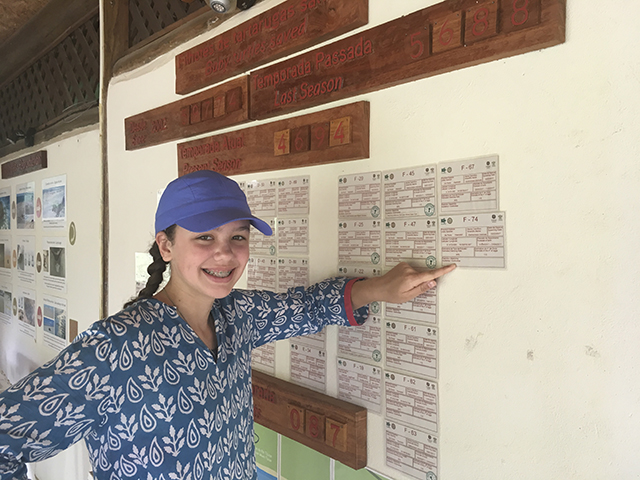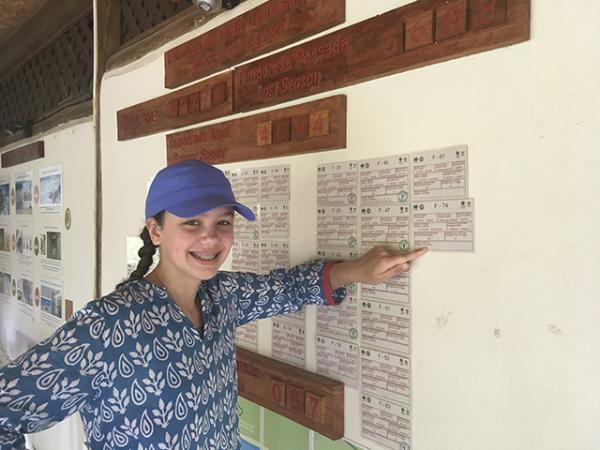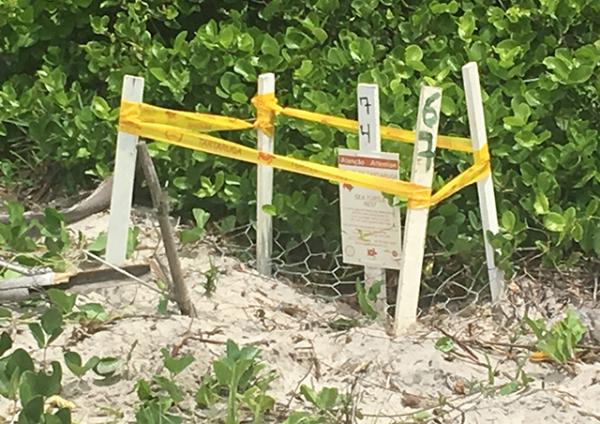KID REPORTERS’ NOTEBOOK
Saving Sea Turtles in Brazil


Lilian points out the information cards that Capixaba creates for sea turtle nest he finds.
I recently traveled with my family to Itacare, Brazil. Itacare is a small town in the state of Bahia, which is known for its beautiful beaches. While there, I met a man named Alvimar Valadares. He walks more than 12 miles a day barefoot, looking for sea turtle nests on the beaches and picking up plastic.
Sea turtles are an endangered species in Brazil and around the world. Valadares, who prefers to be called “Capixaba,” wants to help save the species. A local hotel sponsors his work.
Several years ago, the hotel manager noticed a group of people watching in awe as Capixaba rescued three baby sea turtles from a nest they were trapped in. The hotel realized that these turtles were great ambassadors. They draw people’s attention and make them want to learn about and protect the local ecosystem.
Capixaba has worked in the hotel’s Tartaruga program for the past 15 years. (Tartaruga means turtle in Portuguese.)

Lilian and her brother in Brazil with “Capixaba”
“A JOB TO DO”
Each morning, Capixaba looks for new tracks that have been left overnight by mother sea turtles sliding their bodies through the sand to lay eggs. When he detects a new track, he locates the nest, marks it with stakes, and covers it in mesh to protect it from predators.
Capixaba logs all of the information about the nests on a card so that he can remember the species, how many eggs are laid, and when they are expected to hatch. This year, he has monitored 87 nests.
Capixaba also picks up trash that he finds on the beaches. Sea turtles often mistake small bits of discarded plastic for food. That is the leading cause of turtle deaths in the coastal areas of Brazil.
“These turtles have a job to do,” Capixaba explained on a morning walk to monitor the nests. “They eat coral. If not for them, the coral would overpopulate and kill other species.”*

Sea turtle nests are often far up on the beach and partly hidden in leaves so that wild animals won't eat the eggs.
In addition to tracking and monitoring the sea turtles’ nests, Capixaba meets with local schoolchildren and fishermen to teach them how to preserve the ecosystem. The more that people know, Capixaba said, the more they can help protect the turtles and the environment.
For example, since turtle hatchlings follow the reflection of the water to get to the ocean, it’s important for local houses and hotels to keep their lights dim at night. That way, the hatchlings won’t get confused about which way to go.
“I really like to work with and teach kids,” Capixaba said. “They’re the ones who are going to change this [and help the turtles].” Then he let me hold one of the turtle eggs!
*All quotes have been translated from Portuguese into English.
